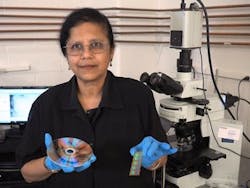Single-molecule imaging could get boost from nanoscale technology to study diseases
A team of researchers at the University of Missouri (Columbia, MO) has developed a relatively inexpensive imaging platform that enables single-molecule imaging and, therefore, could transform how scientists study molecules and cells at nanoscale levels.
Shubra Gangopadhyay, an electrical and computer engineer at the University of Missouri College of Engineering who led the work, explains that scientists usually have to use very expensive microscopes to image at the sub-microscopic level. So the techniques she and her team have established, she says, help to produce enhanced imaging results with ordinary microscopes. What's more, the low cost to produce their platform also means it could be used to detect a wide variety of diseases, particularly in developing countries.
The custom platform uses an interaction between light and the surface of the metal grating to generate surface plasmon resonance (SPR), a rapidly developing imaging technique that enables super-resolution imaging down to 65 nm—a resolution normally reserved for electron microscopes. Using HD-DVD and Blu-ray discs as starting templates, a repeating grating pattern is transferred onto the microscope slides where the specimen will be placed. Since the patterns originate from a widely used technology, the manufacturing process remains relatively inexpensive. In previous studies, Gangopadhyay says, she and her team used plasmonic gratings to detect cortisol and tuberculosis.
Full details of the work appear in the journal Nanoscale; for more information, please visit http://dx.doi.org/10.1039/C5NR09165A.


